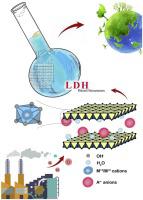Trends in Environmental Analytical Chemistry ( IF 11.1 ) Pub Date : 2021-07-17 , DOI: 10.1016/j.teac.2021.e00139 Hessamaddin Sohrabi 1 , Alireza Khataee 2, 3, 4 , Shahin Ghasemzadeh 1 , Mir Reza Majidi 1 , Yasin Orooji 5, 6

|
One of the most severe environmental problems is heavy metal contamination, putting the world's sustainability at risk. Much effort has been put into developing sensors that can be taken anywhere to detect the environmental effects of heavy metals. Sensitivity, selectivity, multiplexed detection ability, and mobility enhance significantly when nanoparticles and nanostructures are incorporated into sensors. LDHs (layered double hydroxides) have gotten much attention in analytical chemistry in recent years because of their benefits, including their large specific surface area, ease of synthesis, low cost, and high catalytic efficiency and biocompatibility. LDHs are often manufactured as nanomaterial composites or created with specialized three-dimensional structures depending on the application. However, in these settings, LDHs (as color indicators, extracting sorbents, and electrochemical sensing) are usually restricted. Upcoming signs of progress and development possibilities of LDHs in analytical chemistry are reviewed in this paper to assist overcome these problems. Furthermore, the approaches used in the design of LDHs, including structural aspects, are defined and assessed in preparation for future analytical applications. The latest advances in optical and electrochemical sensors to detect heavy metals are described in this review. The sorts and characteristics of LDHs will be explored first. We will then go into microelectrode (or nanoelectrode) arrays, nanoparticle-modified electrodes, and microfluidic optical and electrochemical sensing assays in detail. This paper also discusses design strategies for LDH-based nanostructured sensors and the advantages of using nanomaterials and nanostructures.
中文翻译:

基于层状双氢氧化物 (LDH) 的电化学和光学传感评估,用于量化和识别水和环境样品中的重金属:现状和前景回顾
最严重的环境问题之一是重金属污染,这使世界的可持续性面临风险。已投入大量精力开发可随处携带以检测重金属对环境影响的传感器。当纳米颗粒和纳米结构被结合到传感器中时,灵敏度、选择性、多重检测能力和移动性显着提高。LDHs(层状双氢氧化物)因其比表面积大、合成容易、成本低、催化效率高、生物相容性好等优点,近年来在分析化学领域备受关注。LDH 通常制造为纳米材料复合材料或根据应用使用专门的三维结构创建。但是,在这些设置中,LDH(作为颜色指示剂、提取吸附剂和电化学传感)通常受到限制。本文回顾了 LDH 在分析化学中即将出现的进展迹象和发展可能性,以帮助克服这些问题。此外,定义和评估 LDH 设计中使用的方法,包括结构方面,为未来的分析应用做准备。本综述描述了检测重金属的光学和电化学传感器的最新进展。首先探讨LDHs的种类和特征。然后,我们将详细介绍微电极(或纳米电极)阵列、纳米粒子修饰电极以及微流体光学和电化学传感分析。









































 京公网安备 11010802027423号
京公网安备 11010802027423号